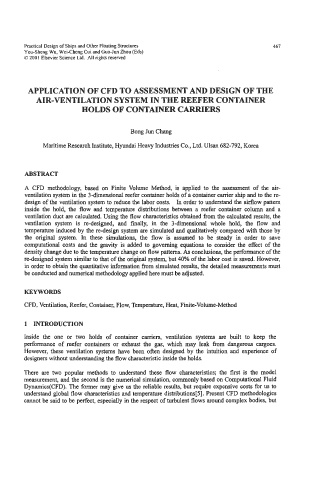Page 492 - Practical Design Ships and Floating Structures
P. 492
Practical Design of Ships and Other Floating Structures 467
You-Sheng Wu, Wei-Cheng Cui and Guo-Jun Zhou (Eds)
8 2001 Elsevier Science Ltd. A11 rights reserved
APPLICATION OF CFD TO ASSESSMENT AND DESIGN OF THE
AIR-VENTILATION SYSTEM IN THE REEFER CONTAINER
HOLDS OF CONTAINER CARRIERS
Bong Jun Chang
Maritime Research Institute, Hyundai Heavy Industries Co., Ltd. Ulsan 682-792, Korea
ABSTRACT
A CFD methodology, based on Finite Volume Method, is applied to the assessment of the air-
ventilation system in the 3dimensional reefer container holds of a container carrier ship and to the re-
design of the ventilation system to reduce the labor costs. In order to understand the airflow pattern
inside the hold, the flow and temperature distributions between a reefer container column and a
ventilation duct are calculated. Using the flow characteristics obtained fkom the calculated results, the
ventilation system is redesigned, and finally, in the 3-dimensional whole hold, the flow and
temperature induced by the redesign system are simulated and qualitatively compared with those by
the original system. In these simulations, the flow is assumed to be steady in order to save
computational costs and the gravity is added to governing equations to consider the effect of the
density change due to the temperature change on flow patterns. As conclusions, the performance of the
redesigned system similar to that of the original system, but 40% of the labor cost is saved. However,
in order to obtain the quantitative information from simulated results, the detailed measurements must
be conducted and numerical methodology applied here must be adjusted.
KEYWORDS
CFD, Ventilation, Reefer, Container, Flow, Temperature, Heat, Finite-Volume-Method
1 INTRODUCTION
Inside the one or two holds of container carriers, ventilation systems are built to keep the
performance of reefer containers or exhaust the gas, which may leak &om dangerous cargoes.
However, these ventilation systems have been often designed by the intuition and experience of
designers without understanding the flow characteristic inside the holds.
There are two popular methods to understand these flow characteristics; the first is the model
measurement, and the second is the numerical simulation, commonly based on Computational Fluid
Dynamics(CFD). The former may give us the reliable results, but require expensive costs for us to
understand global flow characteristics and temperature distributions[5]. Present CFD methodologies
cannot be said to be perfect, especially in the respect of turbulent flows around complex bodies, but

